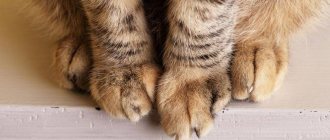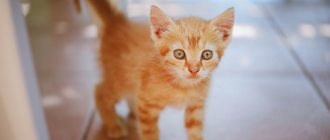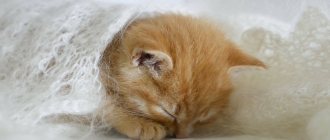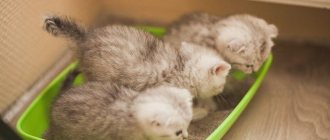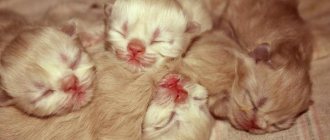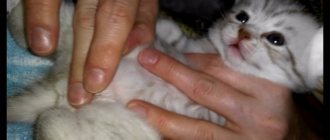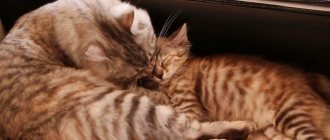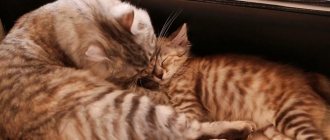If there is a new addition to your cat family, get ready for sleepless nights. And don’t even try to deceive yourself by the temporary helplessness of babies and their dependence on their mother.
Pretty soon, the fluffballs will stop crawling and confidently stand on all fours in search of adventure. At this point, you will have to answer for their safety. But knowing what time kittens begin to walk, you can protect them from possible problems, injuries and deviations.
When a baby first stands on its paws and stops crawling
Until the baby learns to walk and leave the nest, mother's milk will be the only food.
During the first week, the babies move, moving with their front paws, as if they were swimming. The eyes begin to open on the 5-7th day. Final expansion occurs by two weeks of age.
An attentive cat lover, waiting for the moment when the kittens begin to walk, observes the following stages of development of the cubs daily:
- 1-7 - blind cubs swarm around their mother;
- 8-11 - the eyes begin to open, the kittens distinguish the light, smell the mother from a distance;
- 12-15 - first attempts to rise on their paws;
- 16-20 - the cat makes its first timid movements, constantly stumbles and staggers;
Three-week-old cubs can already walk, but some babies are delayed in development. This is due to their condition at birth and the quality of mothers’ nutrition.
Until the cub learns to walk and leave the nest, mother's milk will be the only food.
How does a cat's locomotor system develop?
The musculoskeletal system consists of bones, muscles and joints. Only the hind legs are a direct continuation of the cat's skeleton. The forelimbs do not have a solid joint. They are connected to the skeleton by elastic and strong tendons. They provide smooth landings from great heights and a silent gait.
The hind legs are always stronger than the front legs, since they have to take a much larger load. They serve as support and help push off while running and jumping.
Full development of the body takes about a year, but motor function becomes available to babies already at 1 month of life. During this time they go through the following stages:
- Moving by crawling. In the first 5 days, pets move only in the direction of their mother to eat. By day 10, they begin to use their front legs. Pushing off the floor with them, the kittens ride more and more confidently on their bellies, like swimmers.
- Standing on your front paws. The first attempts are made in 1.5-2 weeks. By the end of this stage, the hind limbs also become stronger, expanding the available capabilities.
- First steps on 4 paws. When making their first movements, babies are guided by their mother. Repeating after her, they sway strongly and often fall out of the blue, but with each attempt they become closer to the goal.
- Gradual improvement of coordination to the level of adult animals. From the 3rd week, animals try to master not only walking, but also running and jumping. During the game, they can fight each other or hunt for their own tail.
The movements of whiskered pets at 1 month are very different from the timid attempts to learn to walk in the very first stages. By this age, small pets no longer fall over while running, actively play with each other and make confident jumps on low surfaces.
Everything about the development of cat paws, what you need to pay attention to
If the baby is 2 weeks old and its eyes have not opened, it is recommended to moisten them with strong tea.
Three-week-old babies begin to explore the surrounding area, gradually moving away from the nest. They come across a feeder, which should be full during lactation.
Conscientious owners use super-premium dry food that is suitable for kittens.
At this time, the felinologist needs to pay attention to the location of the den:
- choose a secluded place for the nest so that no one steps on the crawling baby;
- There should be no household appliances, wires, sharp or prickly objects near the resting place.
- The basket should not be placed on a hill so that the children do not fall out and hurt themselves.
Important! Children need to be taught how to handle kittens so as not to cause harm.
Transition period
This stage begins from the moment the kittens' eyes open and lasts until the animals begin to walk. From about 10 to 15-20 days.
At this time, the kitten begins to hear and see the world around it. In addition, the musculoskeletal system is strengthened, and the kitten begins to walk a little.
The transition period marks the beginning of the kittens' socialization, when they develop attachments to each other and to their mother. At this time, favor and affection for the person is also established. To make a cat tame and affectionate, it is important to gradually establish contact with the kitten. The owner needs to pick up the kitten and caress it, increasing the time from 2-3 minutes at first to 40 minutes daily.
Also during the transition period, the role of the mother as a teacher and controller increases. With the help of games and communication, she regulates the behavior of kittens, teaches them the basics of hunting and interaction with the outside world. The owner can also take part in this process. It is important to introduce your kitten to new smells and sensations through toys and other safe objects.
When their eyes open
The process of eye opening in cubs of different breeds begins on the 5-9th day of life. Delays may occur if the baby was born weakened or the mother is not fed correctly.
Be sure to read:
How to distinguish a male kitten from a girl: a newborn, in the first days of life
Experienced breeders know breed differences. Beginning cat lovers should know that girls' eyes open earlier. Babies of long-haired breeds mature later than short-haired ones.
If the baby is 2 weeks old and its eyes have not opened, it is recommended to moisten them with strong tea or diluted boric acid and try to move them apart. In case of failure, contact an experienced felinologist or veterinarian.
Newborn kittens
Like everyone else after birth, kittens are absolutely helpless creatures. Their ears are flattened, their eyes are closed, the muscles of their limbs are not developed, they cannot walk and maintain their body temperature, so they find it difficult to navigate in space and they need maternal care and care. All these functions develop with age, but for now they are replaced by the mother cat. In the first days, she feeds them, protects them, licks them, warms them with her warmth, and makes sure that the kittens do not crawl away. At this age, babies should not be picked up without special reasons, as the cat may refuse to feed them due to the foreign smell.
The only thing a baby is born with is the sense of touch (smell). With its help, kittens determine their mother's smell and, focusing on it, crawl towards her on their belly for short distances, helping themselves with their front paws. Usually, each kitten identifies its mother’s nipple by smell, and, by fingering it with its paws, stimulates milk production.
In the first days of life, most of the time animals cannot walk and are in sleep, interrupting it only to eat. Since they have developed sucking, swallowing reflexes and the “shelter” reflex (they hide their muzzle and nose in warm and soft places).
Newborns cannot defecate on their own, so the mother cat licks them several times a day to stimulate excretory function. The excretory reflex appears only at 3 weeks of age. At this age, the first complementary foods (homogeneous liquid food, milk or kitten food) can also be introduced into the diet, followed by more solid foods later. During this period, they develop independent bowel movements and need to teach them to go to the litter box.
Starting from the 8th day of life, cats develop sensory functions and their eyes open (they become fully sighted by two weeks), which increases their confidence, and they begin to develop their paws. After 14 days, babies begin to rise on their feet and walk.
© shutterstock
The nuances of caring for a kitten
When the baby gets stronger, becomes curious, and begins to explore the world around him, he needs to be warned against trouble. All dangerous objects are removed from places where the cubs roam.
When the baby gets stronger, becomes curious, and begins to explore the world around him, he needs to be warned against troubles.
Kittens can get stuck in narrow places on furniture, secluded corners behind sofas, cabinets, get tangled in curtains, cling to the tablecloth and drop dishes on themselves.
The cat should not be pulled by the paws or kicked.
Slippery floors are especially dangerous. A child who gets angry can jump onto a smooth surface and damage a tendon or joint. Healthy cubs do not squeak when walking and do not limp. If something bad happens, your pet needs to be shown to a veterinarian.
The kitten should not be placed on a closet or sofa.
His ligamentous apparatus is underdeveloped, the bones have not formed. Instinct makes him jump off. This leads to injury. At the age of one month, babies play pranks, jump on their sisters and brothers, watch their mother, and try to imitate. By observing the cat's behavior near the feeder, babies become accustomed to eating solid food.
Six to eight week old pets are ready for independent living. At this time, the owner decides what to do with them - keep them, put them up for sale or give them to friends.
At this point, a responsible owner of kittens will vaccinate the pet against viral diseases, having previously treated it against worms and fleas.
How to protect a kitten starting to walk on its own
It’s not for nothing that they say that a kitten is the same as a child. He still doesn’t understand many things, which screaming and violence definitely won’t help him with. Kittens often get into trouble when the premises are not properly prepared, or even without that. They may be attracted to the back of the sofa, curtains, tablecloth, wires, carpet, household chemicals, and various narrow and high places. All this is for testing and subsequent assessment of your capabilities.
Examples of equipment for kittens depending on age
Sudden and strong movements of both the kitten and its owners (especially children) are dangerous. The bones are thinner than they might seem, and the paws can easily dislocate or crack the bone tissue. Kicking, even smooth ones, is extremely dangerous. You may accidentally step on your paws by staggering or being distracted by something. It is forbidden to pull the paws and spread them to the sides.
If the baby needs to be transported, it is better to constantly hold him in your arms, since any shaking in transport can cause a fracture, dislocation or crack.
Do not sit your pet on chairs, sofas or other high surfaces. If you let your guard down a little, you might not notice how your baby will fall and hurt himself. It’s better not to lift it high, considering how nimble and fast they are, not yet able to control their sharp claws. We do not recommend placing small kittens on slippery floors, as this will prevent them from learning to walk normally.
Expert advice
Veterinarians and experienced felinologists advise animal lovers who decide to get a kitten to do the following:
- Once pregnancy is established, the cat is switched to premium dry food or higher and is provided with sufficient food.
- At 2 weeks the baby's incisors erupt, and from three weeks the animal can chew granulated food. From this moment on, kittens are given dry food. By the age of two months, the cat's mouth will be armed with twenty-six teeth.
- For the safety of the babies, they are given a special playpen for kittens.
- The area around the cat's den is covered with carpet.
- Before the babies get stronger and begin to leave the nest, dangerous objects are removed.
Be sure to read:
Mating males and females: features, age, how to determine readiness, first mating, recommendations
If the kitten is injured, call a veterinarian. You cannot hesitate, otherwise the cub will die or become disabled. Transport to a hospital may worsen the injury. The cat is kept motionless until the doctor appears.
What problems are possible?
If by the end of 3 weeks the kitten does not stand on its legs, squeaks or even shows no attempts to move, this may be a reason to seek help from a veterinarian. Weak limbs or possible pain may be signs of congenital and acquired pathologies such as:
- musculoskeletal disorder;
- rickets (metabolic disorder with subsequent changes in the skeleton due to a lack of substances);
- kidney diseases;
- oncological diseases;
- poisoning;
- hip dysplasia (misalignment of the pelvic bowl with the head of the femur
- various injuries.
To avoid harming your pet, call a veterinarian at home
All of these problems can be of varying degrees of severity and can be treated if treated in a timely manner. Experts advise monitoring your pet in this regard for at least six months, and also checking for notes on breeding diseases in the pedigree, since many popular breeds are bred by selective breeding and are more susceptible to dysplasia and rickets.
At what age can kittens be given away?
Only by 12 weeks is the kitten more or less ready to leave its mother cat and begin an independent life with its owner. At this time, the immunity that the baby receives from mother's milk declines. Immunity begins to develop after vaccinations, which means that the baby can now do without the mother’s breast and is somewhat stronger. Earlier weaning risks diseases, including such common ones for kittens as diarrhea and respiratory diseases, accompanied by frequent sneezing.
If the kitten has already been vaccinated (the first vaccinations are against panleukopenia, calcivirus and rhinotracheitis), this does not mean that the kitten will now not succumb to these diseases. There is no immunity yet until repeated vaccination. And some cats also need later vaccination - at 16 weeks, and not at 12, as usual. In addition, the kitten must be well physically developed and gain weight - then it will be easier to bear separation from its mother and moving to a new home.
There are also problems that arise if you take a kitten too early. An important stage in the life of a cat cub is weaning from the mother's breast. No one will do this as correctly, carefully and firmly as the cat mother herself. If weaning is not done correctly, serious behavioral problems can be expected in the future. A sudden change in diet also negatively affects the baby’s body - the resulting diarrhea (diarrhea) is a consequence of poor nutrition and the cause of dehydration, which poses a real threat to life.
It is the mother who teaches her cub to communicate with other animals, to “talk” in cat language. If you deprive a kitten of these first lessons, he may become intimidated, timid, insecure, even cowardly or, conversely, inexplicably aggressive. In a word, the psyche will be upset. Older kittens adapt much better to a new environment, and they experience curiosity rather than fear towards their owner, since they have already received their first lessons from their mother and feel some self-confidence.
In the company of its mother, the kitten is not afraid to meet a person. He sees that the mother is not afraid of people and also does not feel afraid of them. If new people appear in a kitten’s life without a mother, while he has not yet had time to fully get used to them, he may be afraid of them all his life. Something like a phobia develops - a person in a tie or sunglasses may seem very scary to the animal if such people have never appeared with the mother.
So, the optimal age when you can take a kitten from a cat to a new home is about three months. Occasionally - earlier, if the kitten is developed, active, playful and has no health problems.
What is he like, a kitten at three months old?
Firstly, he is most likely weaned from his mother's breast. This means there are no problems with feeding, he can eat solid food. Secondly, the kitten's immune system is fine
The necessary vaccinations are behind us, and the risk of various diseases is sharply reduced. Thirdly, the kitten is ready to communicate with people and other animals (this is very important if there are already cats and dogs in the house).
Of course, everyone wants to see the development of a baby kitten literally from the first steps, to observe this defenselessness and the formation of character. But over time, the kitten will turn into a cat, whose behavior and health will largely depend on what happened to it at an early age. Therefore, it is better to overcome the desire to take a very small kitten into your home.
Let him spend a couple of extra months with his mother, where he is warm, calm and comfortable. In this case, there is a greater chance that the cat and the owner will not have any particular problems. She will be cheerful, healthy, playful, confident and always ready to give a person joy and her friendship.
Therefore, the future owner needs to be patient - a month or two of waiting is not such an expensive price to pay for a dozen happy years.
How does a baby's crawling develop speech?
Some mothers are terribly worried if the child begins to stand and walk a little later than expected: “There must be something wrong with him.” And there are those who boast: “And mine started already at ten months.”
Of course, all parents rejoice watching how their child grows and develops: at first the baby can only suckle, but gradually learns to perform all the actions familiar to a person. Parents look forward to seeing their child begin to stand and then walk. Therefore, you can understand their feelings: they are worried if the baby starts walking later than the others, and if earlier, this is a reason for them to brag.
But it’s very bad if these feelings in parents turn into a desire to wean the child from crawling as quickly as possible and immediately teach him to walk. No need to rush things
If parents force this process, the child will lose a very important stage of development. And instead of a reason for pride, parents will have a reason to worry
A newborn baby cannot hold up its head, so adults must support it when picking up the baby. This happens because the baby's neck muscles are not yet developed. At about three months, babies begin to hold their heads upright. At four months they can already lift and turn it. In pediatrics, this rate of development is considered the norm. To crawl, a child needs to be able to lift his head - these two skills are directly related.
When the baby crawls, he tries his best to raise and hold his head. This movement is different from raising the head when the child is lying on his back: to crawl, you need to lift the head from the chest, as if throwing it back. Crawling stimulates the development of the brain and neck muscles, and this stage cannot be skipped.
In modern medicine, it is believed that children who missed the crawling stage or who crawled little are much inferior to their peers in terms of development of speech abilities. Professor Glenn Doman, founder of the American organization Institutes for Achieving Human Potential, presented research showing that the speech skills of children who did not crawl but immediately began to walk differ from those who went through the crawling stage.
He noticed how significantly the process of crawling affects the human brain, and even suggested using it in the treatment of mental retardation, encephalopathy and partial paralysis after a stroke. According to Doman, the evolution of living beings is associated with the emergence of their ability to crawl
The level of brain development of reptiles is much higher than that of lower animals. It is clear why crawling is effective in treating encephalopathy in infants.
When crawling, you need to raise and hold your head, and this has a good effect on brain development. So you need to support the child’s desire to crawl, and not strive to get through this stage as quickly as possible.
At one time there was active discussion about whether children should be placed on their stomachs. In Japan, this method has been criticized for causing accidents. However, placing a newborn on his stomach develops the same skills as crawling. In order for children who do not yet know how to crawl to learn to raise their heads like little turtles, they are specially placed on their stomachs. But if the bed is soft, the child may suffocate.
Prevention of constipation and diarrhea in kittens
If the owner prefers to feed his little furry with natural products, you need to make sure that the diet contains not only meat, but also vegetables and cereals - these menu components have a positive effect on intestinal motility. Older cats need to add a small amount of steamed bran to the minced meat, which contributes to the balanced functioning of the digestive system.
The diet should definitely include cereal dishes such as well-cooked rice and buckwheat porridge, thoroughly mixed with minced chicken. A stew made from vegetables stewed or boiled in a small amount of water is appropriate. Instead of water, you can use weak meat broth. For vegetables, you can take carrots, beets, pumpkin, or zucchini, cut into small cubes.
Some pets themselves are drawn to cucumber, cabbage, melon, or green peas. In these cases, you need to encourage their appetite and provide your beloved pet with these foods. After all, melons, along with fresh vegetables, help improve intestinal function and help overcome chronic constipation.
When do kittens start walking?
And I’m walking, walking around Moscow.
- Fact:
A newborn kitten has very weak limbs, he does not even try to stand on them - Fact 2:
As soon as the kitten begins to show curiosity about its surroundings, you need to remove everything dangerous from its path. - Fact 3:
Under no circumstances should you pull the paws or push the little prankster with your foot. - Fact 4:
There is no need to put off cleaning up dangerous objects until the baby stands on its paws
This is also interesting!
Typically, kittens settle into a new home when they are already running and jumping with all their might. But if the baby is born to your domestic cat, and it was decided to keep it, the owner bears considerable responsibility. Newborn kittens usually do not need human care, but a growing baby, standing on its paws and eager to explore every corner, is the object of close supervision.
